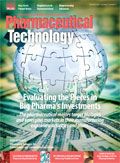Regulatory Roundup
Appropriate use of medications promises to improve patient care and curb spending, prompting pharmacists, public health authorities, and manufacturers to promote multiple adherence strategies.
Pushing adherence
Appropriate use of medications promises to improve patient care and curb spending, prompting pharmacists, public health authorities, and manufacturers to promote multiple adherence strategies. A report card on medication adherence from the National Community Pharmacists Association gives low marks to consumers in filling and re-filling prescriptions and for mis-using medicines—particularly individuals with chronic conditions (1). Similarly, an analysis by CVS Caremark predicts $6.5 billion in annual savings if patients fill prescriptions 80% of the time (2). More broadly, the IMS Institute for Healthcare Informatics projects $200 million in annual savings by using prescription medicines "more responsibly" (3). That savings includes $35 billion from prescribing antibiotics only when necessary and appropriate, plus $105 billion from proper drug use that avoids hospitalizations, emergency room visits, and other care. Manufacturers are offering new solutions to track and promote appropriate medication use, notably through mobile apps and text messaging to remind patients of refills and timely administration. New pills with digestible microchips and sensors may help providers monitor patients taking their meds.
Safe imports?
A new Maine law permits residents to purchase prescription drugs from mail-order pharmacies in Canada and other countries, a move designed to ease access to low-cost medicines. Employers and state agencies predict savings of more than $10 million a year, and supporters of the program maintain that the imported drugs are just as safe and effective as more costly versions in the US—a position that FDA challenges. In fact, FDA continues to work with INTERPOL, foreign regulatory agencies, and manufacturers to crack down on illegal online pharmacies, many part of organized criminal networks that market fake and sometimes dangerous medicines. In a broad enforcement action in June 2013, FDA and international law enforcement agencies took action against some 9600 illegal websites and seized more than $40 million in illegal medicines (4).
Rescuing abandoned drugs
Undeveloped compounds from Astra Zeneca, Eli Lilly, Johnson & Johnson's Janssen, Pfizer, and Sanofi will be studied by academic researchers under the first round of "repurposing" grants from the National Center for Advancing Translational Sciences (NCATS) at the National Institutes of Health (NIH). NCATS is providing $12.7 million for nine research projects that will seek new therapeutic uses for molecules that have been partly developed by manufacturers, but dropped largely due to poor efficacy or for business reasons. The companies are supplying the compounds, which will be tested collaboratively in preclinical through phase 2 studies (5). Industry has been skeptical that the NCATS repurposing program will bear fruit, but the initiative has strong backing from NIH director Francis Collins as a strategy for accelerating discovery of new therapies for critical diseases.
Tracking PDUFA
Instead of waiting five years to assess the successes and shortcomings of the current Prescription Drug User Fee Act (PDUFA), now in its fifth iteration, manufacturers have set up an online system to track actions and results in near-real time. The Industry PDUFA Tracking Database, established by the Biotechnology Industry Organization (BIO) and the Pharmaceutical Research and Manufacturers of America (PhRMA), will collect data from companies on the progress of new applications for drugs and biologics through the review process. Individual companies will have access to data on their own submissions, as well as aggregated, de-identified industry data down to each FDA review division. The aim is for sponsors to enter information in real-time on review outcomes, number of review cycles, timing of meetings and communications with FDA, review letters, and timing of REMS discussions. If the database reveals clear problems with the review process, the information could support changes sooner than the next round of user fee negotiations in 2017.
Challenging India patent grab
Recent actions undermining patent protections for prescription medicines in India has produced a strong reaction from US pharmaceutical companies and support from IT firms and manufacturers in numerous sectors. An industry coalition is pressing the Obama administration to raise concerns about India's unfair trade practices in bilateral and multilateral trade talks and all diplomatic and trade discussions. These issues were discussed at a June hearing before a House Energy and Commerce subcommittee, where Roy Waldron of Pfizer described how India has revoked patents and issued compulsory licenses for a number of leading drugs, most notably Novartis' anticancer therapy Gleevec. Although the Indian government claims its actions are necessary to provide affordable crucial medicines to its population, manufacturers counter that most people in India cannot afford even low-cost generics, and that the government primarily seeks to bolster Indian manufacturers. A greater fear is that India's anti-IP moves will spillover to Brazil, South Africa, Turkey, and other newly industrial countries. Meanwhile, India is moving ahead by authorizing an inter-ministerial panel to set reference prices based on drug rates in Europe, Canada, and other countries.
References
1. NCPA, "New Report Card on Medication Use Gives Americans a C+," Press Release (June 25, 2013), www.ncpanet.org.
2. CVS Caremark, State Adherence Data, www.cvscaremarkFYI.com/adherence
3. IMS Health, Press Release (June 19, 2013), www.theimsinstitute.org
4. FDA, "FDA Takes Action to Protect Consumers from Dangerous Medicines Sold by Illegal Online Pharmacies," FDA.gov (June 27, 2013).
5. NIH, "NIH to Fund Collaborations with Industry to Identify New Uses for Existing Compounds," NIH.gov, www.nih.gov/news/health/jun2013/ncats-18.htm.
